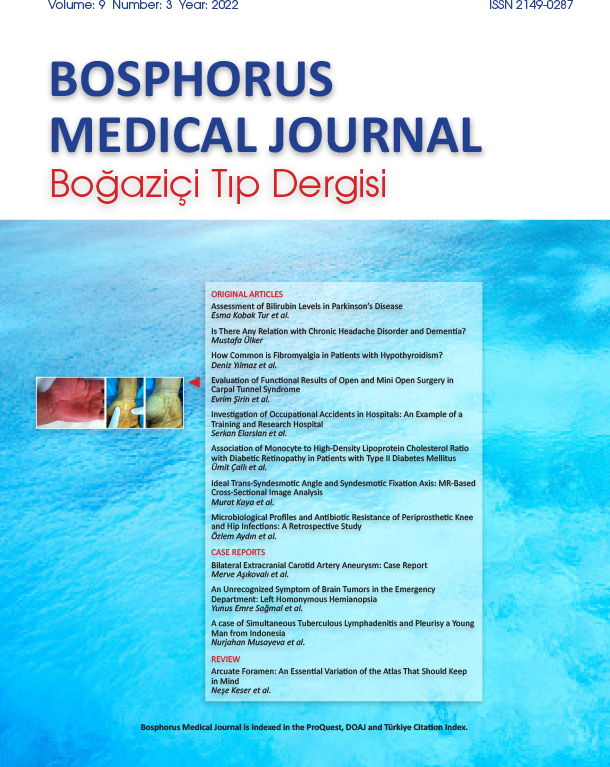The Evaluation of the emerging changes in Nocturia According to its Subgroups in Patients Who Underwent Prostatectomy due to Benign Prostatic Hyperplasia
Abdullah Çırakoğlu1, Ferhat Ateş2, Hasan Soydan3, İlker Akyol4, Temuçin Şenkul5, Kadir Baykal61Ordu Üniversitesi, Tıp Fakültesi, Üroloji Anabilim Dalı, Ordu2Sultan Abdülhamid Eğitim ve Araştırma Hastanesi, Üroloji Kliniği, İstanbul
3Maltepe Üniversitesi, Tıp Fakültesi, Üroloji Anabilim Dalı, İstanbul
4Özel Nisa Hastanesi, İstanbul
5Özel Mehmet Toprak Hastanesi, İstanbul
6NB Kadıköy Hastanesi, İstanbul
Aim: The frequency of lower urinary tract symptoms (LUTS) increase with aging in males. Benign prostatic hyperplasia (BPH) is one of the
most common causes of nocturia in men. Nocturia, which is one of the main symptoms of the LUTS, impairs the quality of life significantly. However, it is not yet known if an improvement in nocturia occurs in patients after undergoing successful surgical treatment for BPH. We aimed to determine the changes that emerge in the number and the types of nocturia according to its subgroups, and the effects this has on the quality of life in men with BPH after surgical treatment. Materials and Methods: Patients with BPH who underwent prosta- tectomy from April 2006 to March 2009 were included in our study. In accordance with the definition made by the International Conti- nence Society (ICS), nocturia was recognized as waking up at night for voiding. We divided our patients into four subgroups of nocturia as follows; polyuria, nocturnal polyuria, reduced bladder capacity at night, and overactive bladder type. The patients were told to keep a diary of voiding for three days three months before and three months after the surgery. Their uroflowmetry and postvoiding urine volumes were recorded. They filled the IPSS and the nocturia specific quality of life (QOL) forms. Prostate volumes were measured with abdominal ultrasonography. The patients other chronic diseases and the recent medical treatments they received were recorded. Results: We found that nocturia decreased in half of the whole group of patients after undergoing prostatectomy (p<0.001). When evaluated according to the subgroups of nocturia, the greatest improvement occurred in the AAM group. In addition to this, we found that changes in subtypes of nocturia can occur postoperatively in some patients. Conclusion: The type of nocturia in men should be evaluated in detail before prostatectomy, as this may be of help in predicting possible improvements in nocturia after surgery.
Benign Prostat Hiperplazisi Nedeni ile Yapılan Prostatektomi Sonrasında Noktüride Meydana Gelen Değişikliğin Noktüri Alt Gruplarına Göre İncelenmesi
Abdullah Çırakoğlu1, Ferhat Ateş2, Hasan Soydan3, İlker Akyol4, Temuçin Şenkul5, Kadir Baykal61Ordu Üniversitesi, Tıp Fakültesi, Üroloji Anabilim Dalı, Ordu2Sultan Abdülhamid Eğitim ve Araştırma Hastanesi, Üroloji Kliniği, İstanbul
3Maltepe Üniversitesi, Tıp Fakültesi, Üroloji Anabilim Dalı, İstanbul
4Özel Nisa Hastanesi, İstanbul
5Özel Mehmet Toprak Hastanesi, İstanbul
6NB Kadıköy Hastanesi, İstanbul
Amaç: Alt üriner sistem semptomlarının (AÜSS) görülme sıklığı yaşlanmayla birlikte artmaktadır. Erkeklerde AÜSSnin en sık nedenlerinden biri benign prostat hiperplazisidir (BPH). AÜSS içinde hayat kalitesini en çok bozan noktüridir. Ancak BPHnın cerrahi tedavisi sonrası noktüri alt gruplarında düzelme olup olmadığı bilinmemektedir. Çalışmamızda prostatektomi yapılan hastalarda alt gruplarına göre noktüride meydana gelen değişiklikleri ve hayat kalitesi üzerine etkilerini inceledik. Yöntem ve Gereçler: Nisan 2006 - Mart 2009 arasında kliniğimizde BPH tanısıyla prostatektomi yapılan hastalar çalışmaya dahil edildi. Uluslarası Kontinans Derneği (ICS)nin tanımına göre gece idrar yapmak için uyanmak noktüri kabul edildi. Noktüri, noktürnal poliüri, gece mesane kapasitesinde azalma, poliüri ve aşırı aktif mesane olmak üzere 4 gruba ayrıldı. Hastalara ameliyat öncesi ve ameliyat sonrası üçüncü ayda üç gün işeme günlüğü doldurtuldu, üroflovmetri yapılıp, işeme sonrası kalan idrar hacmi (PVRİ) belirlendi, IPSS ve noktüriye özgü hayat kalitesi formu doldurtuldu. Prostat hacimleri abdominal USG ile ölçüldü. Birlikte bulunan kronik hastalıkları ve kullandıkları ilaçlar sorgulandı. Bulgular: Çalışmada prostatektomi sonrası hastaların yarısında noktüride azalma olduğu bulundu (p< 0,001). Noktüri alt gruplarına göre değerlendirildiğinde en fazla düzelmenin AAM grubunda olduğu değerlendirildi. Ayrıca prostatektomi sonrası noktüri türünün değişebildiği saptandı. Sonuç: Prostatektomi öncesi noktüri türünün belirlenmesi noktürideki düzelmeyi tahmin etmek için faydalı olabilir.
Anahtar Kelimeler: noktüri, prostatektomi, yaşam kalitesiManuscript Language: English




















